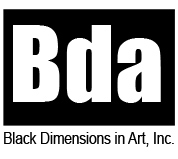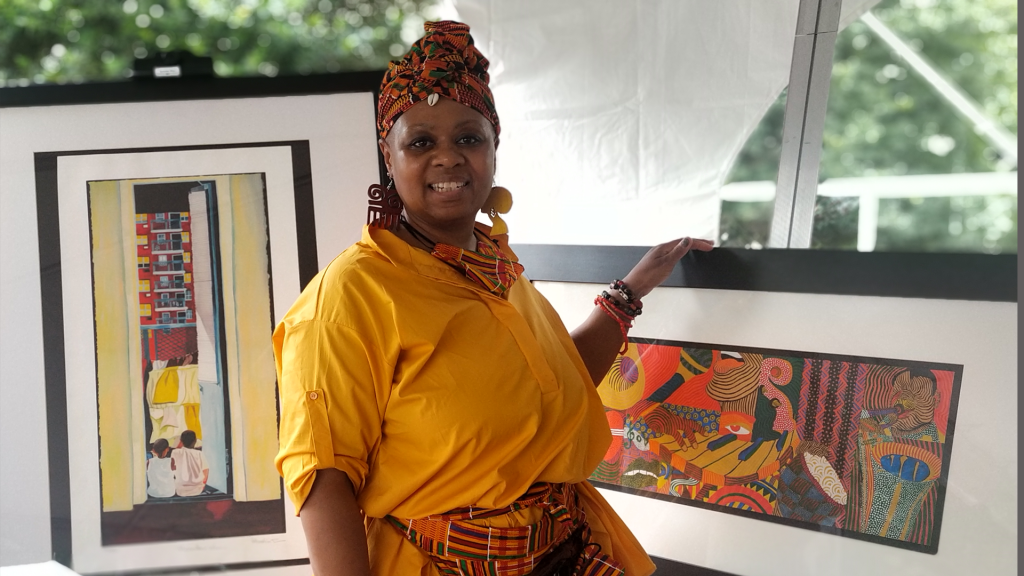
Interview by Dorree Ndooki
Dorree Ndooki: Before we begin, I would like to introduce myself. My name is Dorree and I’m a 22 year old Skidmore College student. I’m majoring in political science with an interest in art, dance and documentary studies. I recently came back from spending my Junior spring semester in France. It was a lifechanging experience that gave me a new perspective in how I approach my studies. I was hoping you could give me a little introduction about yourself- where you’re located and where you’re from.
Aleathia Brown: “Awesome, well I’m already feeling the connections ’cause when you said Paris, that was one of my dream places to go as an artist. I finally got a chance to do that in 2018 and exhibit my work in London while I was there, so it’s just full circle. I understand what you felt about the idea of a whole new direction and travel is imperative for any artist or creatives. With that said I’m located in New York City. I’m a Harlem baby, I live in the Bronx in the northeast Bronx. I always claim to be in both places ’cause that’s really where all of my time is spent professionally as well as family wise. And I’ve been an artist my whole life so there’s never not been that. And in terms of just who I am, where I am, I’m an entrepreneur because I produce a lot of things in addition to the collaboration that I’ve had with BDA. I actually would co-curate some of the exhibitions we would do by bringing some of the upstate artists down to Harlem to exhibit their work in conjunction with us. And then we would come from Harlem up to the Wellington Farm where we would do our exhibit every year for I think about three or four years. So there’s this synergy and history between me, them, us, we. I’m always looking to expand my wings in all kinds of spaces with creatives. I’m actually working with a person who does dance or movement to some of my poetry and we’re getting ready to do a big event next month actually. Dancers and musicians are another part of my lungs. I’m always connected to all of the arts and I’m always coordinating and collaborating with all of the arts in some kind of weaving pattern so this is really wonderful.”
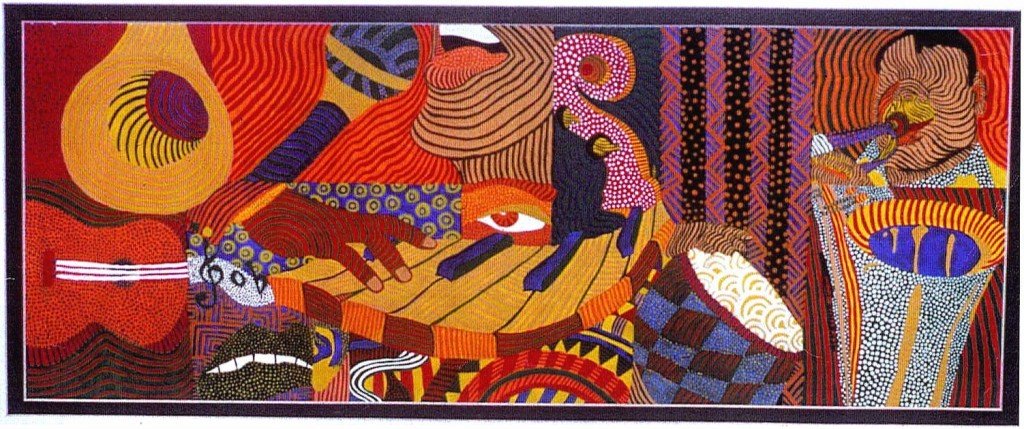
Dorree: How do you collaborate with people when you’re connecting different mediums such as movement, music, poetry..etc. How does your creative process begin?
Aleathia: “There’s no one way because it really is starting from a story. It’s starting from an energy or maybe even just by a project that I was invited to do and create and then figure out how the evolution of that project is gonna go. I’m a storyteller on and off the canvas. I’m always looking at how ‘story’ impacts all of us ’cause we all have a story. And we all have a universal connection to each other when we use that story as our lead into a journey, a past, a future you know whatever the thing is. Poetic movement is to me, ‘story’. It was natural for me to put in front of an audience my poetic side because it was always something that I nurtured on the backside. I would sometimes paint what I would write in my poetry journal. I never felt it was something that I could or wanted to share because I didn’t want people to feel they had a right to criticize or critique that work. I felt like my visual art was the work that I put an armor on. So that people can say what they wanted and feel however they wanted unapologetically. But there were certain other dynamics to me that were really at the core of my creative space that’s only between me and God. I didn’t want to give that voice and light for the longest and then in evolution just when you tell God what you’re not going to do, what happens… you get put on the forefront to do exactly that. The poetic side started coming out as a result of me doing storytelling on stages with The Moth: The Art and Craft of Storytelling. Taking a class with them and just being lured into hearing other people’s reactions to my work was very poetic. And for me poetry does to art what dance does to movement. I was looking at some footage the other day and I see my hands moving about while I’m talking. You’d almost think it was sign language because of the way it was such an integral part of how I was expressing the words coming out. Movement has always been an integral part like me having limbs, me being a woman, and me being brown. Movement and music are always layered into what I’m doing whether it’s on the back end or the front end. So when I’m doing a project, naturally the more space I’m given to have freedom the more likely it’s going to be those layers woven into the forefront. I have another project that’s coming out in our anniversary for Harlem Week this August. Then I asked one of the people in our collective that I found out was a dancer if he could do movement to my poem while I had an interpreter to sign. She does sign alliteration which is more theatrical movement to the signing of some of the words to enhance where they land. I have another friend who’s a DJ and a music producer who created some original music to the piece while I was reciting it on a recorded screen. So it’s all gonna be layered and presented on August 21st. I had the freedom to do what I wanted because it’s my project and every year I do something different and they just give me the stage for a certain amount of time and go, go!”
Dorree: With all of these different languages you utilize to express your art, which medium do you lean into more often?
Aleathia: “It’s like how a circle doesn’t have a beginning or an end there’s no beginning or end to that. When I’m working in my studio I have music on to motivate me to start prepping and then that changes to what playlist I’m gonna play while I’m working. So there’s always music around and then sometimes I’m selecting the music to go with the work when I’m creating. Plus I do live art so when I’m on a stage doing live art it’s usually with live music and a poet performing. There’s no one or the other, it just is. Sometimes it’s deliberate, sometimes it’s organic. That’s the only thing that will change but there’s music always somewhere in us. I did the City Arts Grant Project last year and my project was called “Insomniac.” I wanted to show what people saw with the process and this was the first painting in my whole adult life that I created without music on at all. I had total silence and I did it in the hallway of my building and because of the struggle I went through with my neighbor who was very difficult while I was working on this I kept the silence to keep some of the peace but it was another quiet space that took me in. It changed the color palette that I used, it changed the direction of what I put message wise into the art, so it’s funny how experiments often lead you in a different path. But ‘what would my art look like without music?’ It has a different color.”
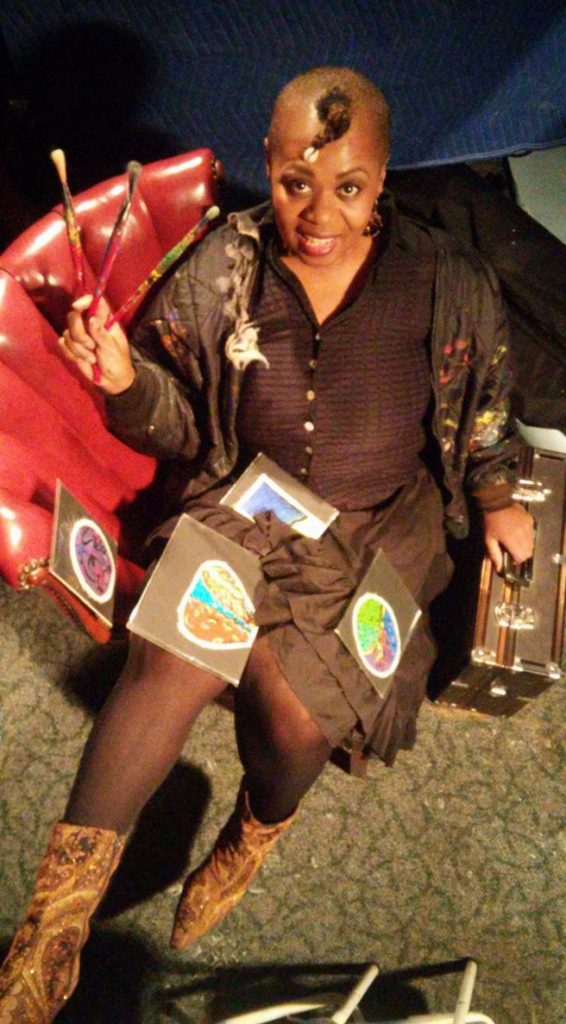
Dorree: Where do you find inspiration for your art? Do you find your inspiration from within or do you also have artists or communities that you get inspiration from as well?
Aleathia: “ Everything. There’s no one place that it comes from. Inspiration comes from inspiring and being inspired. I’m a sponge so just like clouds collect water and then you have rain, what rains is that I will surrender to whatever it is that inspires me in that moment. It could be a word somebody said, it could be a conversation I overheard somebody having on a bus, it could be me dancing with my eyes closed. There’s no one, two with it. The thing that’s interesting is which ones I select to attack first. There are so many more pieces in my head that I haven’t even come near to and then there’s the things that sort of bum rush me in the front.”
Dorree: In the past, you’ve spoken about how your home is used mainly for your art. Is this still the case or do you prefer to work in a studio or outside?
Aleathia: “I work outside when I need to, if and how the project is called for. I did a mural in Harlem in 2017 on the exterior of a church wall. So there’s the public art, the things that sort of you know curate themselves into being outside. I’ve always taken photos and used them as studies and references for things. Since the pandemic, when I couldn’t breathe, I had this affinity with trees which is why this project is perfect for me because I live where I live. I have to be around them at least once a day. I started going on these walks in nature in parks and trails. I started documenting trees and water and so I’ve photographed hundreds, probably 1000 or more situations.”
Dorree: In regards to climate change, how do you connect your relationship to nature and the art you create with the concerning climate future we face?
Aleathia: “For me it’s just by virtue of me being a collector of trash if you will in the most profound way. I use a lot of found objects, repurposed a lot of things and even when I’m teaching and having workshops. Almost always I’m using some kind of recycled something. I’m always looking at the ingredients of things and how it’s being used and even the adhesives that I use. I’m always conscious of what I use, how I’m using what I’m using. I eat that way and even at home it’s like there are certain things I do and don’t do deliberately. I’ll even sometimes come up to people throwing their trash and like, ‘don’t do that, can you pick that up?’ As a child this commercial they had on where a Native American came up on the side of the road. Someone threw trash out the window as they were speeding past and you see the close up of the Native American with the tear rolling down his face. That has been me since that visual impact to me ’cause I don’t understand people throwing trash on the sidewalk or just deliberately being mean to the planet that they’re getting so much life from.That whole thing about energy waste when we can use solar energy for how we have these lights on and power on. We can be more productive if we weren’t so capitalistic in how we’re using our resources unnecessarily. I know I don’t come from this planet ’cause I don’t fit with the way the mindset goes on here and from the time I was a little girl when people would ask, I would say, I’m not from this planet. [Laughter]. People think I was playing but I really was serious about that, like I know my brain doesn’t operate on this frequency because of the things that I hear people say, think, do, not do. And I am often saying ‘where aren’t we?’ Not ‘where are we?’ That is something we need to work on. Where ‘aren’t we?’”
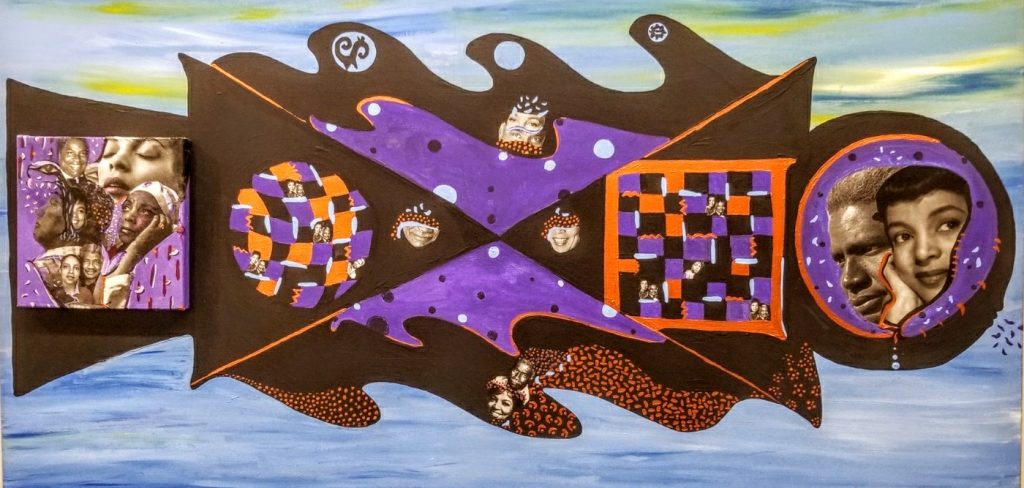
Dorree: I wanted to see how you’ve been holding up in terms of the pandemic and how it’s affected you within your art.
Aleathia: “One of the most integral parts of change was having to do what we’re doing now, being on virtual. Within the first ten days of the pandemic, I took a zoom class to learn how to use the virtual in order to start migrating that into my work, my being, and my communication. See as an artist we’re in isolation all the time anyway so this was actually grand for me to be in isolation. ‘Like what?’ ‘I get to be home and work and decompress?’ I was going on very long walks every day. Me and two of my friends who lived up the street from me in all kinds of neighborhoods all around here. There wasn’t a day that I did not do that first, it opened the lungs. Then I kind of repurposed and dismantled my bedroom to become my art lab so that I could start building and repurposing. Then those walks in nature for photography really took a lot. When I didn’t use the paintbrush, I used the lens as my color palette for what I was absorbing. I’ve had to keep reinventing myself on a platform and go ‘well, you don’t have to ask for permission to work, you’re an artist, you’re an entrepreneur.’ ‘You can work and create and then sell your work on other platforms.’ In that sense it pivoted me to selling more of my work in ways that I hadn’t been. I’ve sold more of my work in these couple of years than I have in the past five years. Interestingly when I had to say ‘okay you have to survive. How’s that going to look honestly?’ It seems like adaptability is the best way we can move forward and through this.”
Dorree: I still don’t feel comfortable calling myself an artist. But I feel blessed to be able to witness artists move through impossible situations with their art. And create spaces of understanding or tools to help everyone move through devastating situations like the pandemic…
Aleathia: “I gotta question you, ‘what makes you uncomfortable about calling yourself an artist? Are you uncomfortable calling yourself a woman, Black?’”
Dorree: “That’s a great point, um no, no I’m not. I think it’s because at least in my relationship with dance, I really really loved it when I started it. And then I went to a dance school that pushed everyone to try to be professional. I felt like at my young age at that time I wasn’t interested in that. I just want to dance, I wanted to create, I wanted to choreograph. So I felt like ‘well if I’m not fitting this box of what this dancer should be, what my future as a dancer should be, am I really a part of it?’ Then I actually stopped dancing for a few years. Since that period up until now it felt hard introducing myself because a lot of people knew me as a dancer. But now a lot of people in college have no idea that I do that. So I feel weird saying that I’m a dancer because I haven’t done it in so long and I don’t have things to show for at the moment, so I don’t feel comfortable.”
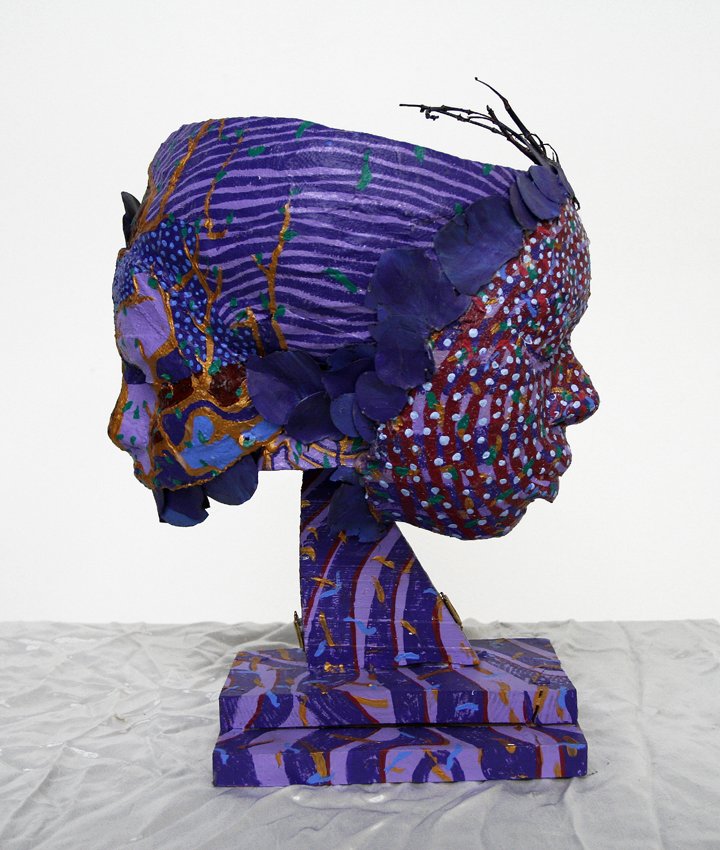
Aleathia: “So rename it so you can say I’m a movement practitioner. Why does it have to just be a dancer? Because dancer is in the eyes of those who construct that as a criticism as opposed to an idea that has a reality. You are a movement practitioner and you’re not limited to dance. This is the thing about an artist: you can make your world. Make your world. If the world you’re in doesn’t fit you, make your world. And then watch the language change. I use this term that I created called ‘relanguage.’ So that the same dynamics on something that got a negative push has a positive impact. So ‘relanguage’ that word dancer. Because whether you are activating it or not your mind is a dancer. A little boy said to me one time in a workshop I was doing, “I’m not an artist like you.” I said the only difference between me and you is that I surrendered to this as a practice and you are resisting it as something as a punishment. I said what would it look like if you were in a surrender that you can do whatever you wanna do, with or without a name. ‘Why give it a name if it’s giving you pressure?’ Take that name off and do something else with it. Give yourself permission that you are not going to fall prey to what other people have judgment on. This is why I said I don’t fit on this planet. See how automatically I am not going to allow someone to define me? I do that. So you call me by the name I give. So what do you want us to call you?”
Dorree: What do you have to say to young artists who are just finding their place in their own work and also within the artworld in general? It is also a question for you in how you feel your positionality is in the artwold today.
Aleathia: “So the first and foremost thing is to absorb every modality in your platform that you can learn so that you can explore where your voice needs to be developed. As an artist of any creative discipline, think about the word discipline and how it’s attached to art. It has a discipline because it has a focus and it has a level of excellence that drives you towards. As a disciplinarian in the arts you must learn the formalities and the bone structure. The bone of your body is your foundation. Learn the foundation of it as a discipline so that you can dismantle it. I would use burlap and then I shred it, and dismantle it. There’s something beautiful about it being unraveled. So when you can have the power of learning this, finesse it. A perfect example is this because you know my mind works for the dance as well.You learn a dance but then you have to learn how to language it in your own finesse style. There’s never gonna be a dance that you’re gonna just do based on the way it’s been choreographed. It now has to speak to your spirit, your energy, your flow, your body. That’s where you become at one with that dance. That’s the same thing in any art discipline, to become at one is to have excellence, and to have excellence, the discipline of that is learning it from the inside core and then expelling it. And then renaming it and then reshaping it and finding your voice. I could take something from an old master in the visual arts and then reframe it into my own shape by putting elements of my spirit into it. It takes a certain level of skill to be able to do that. That’s what comes with learning so many different forms of dance. Learn martial arts, Tai chi and capoeira. Learn these other disciplines and then see how it incorporates how you move your body and how you maintain your body. I was doing printmaking and sculpture and photography and acrylic and oil and pastel. I did all the disciplines in the early stages so that when I start a piece it’s not about the visual image it’s about the story. And the story is coming through the texture. Art is like making a pot of soup. That stuff at the bottom, the gooey good stuff, that when you stir it into the pot, it gives it all the life and flavor. For me it’s ‘do I use pastel or do I use acrylic or do I use photography? Do I use a combination of glass and wood? Am I using water?’ All those things are starting to inform where this story is going to begin. I can use all those mediums because I did welding and I did woodworking. I was one of the first in my junior high school to insist that girls should be allowed to be in other shops besides home economics and so on.”
Dorree: Wait, you weren’t allowed in the shop?
Aleathia: “There was once upon a time where the boys did automotive, wood, metal shop. Me and some of the girls in the school did our resistance thing and we were the first three to be allowed in the wood and metal shop. I was like ‘because of what’s in my pants I can’t do this?’ There will be things that make no sense and when it hits the space in between your ears and you go ‘wait what?’ I make my world. And same thing with racism, you being Black, you being female there’s all kinds of isms that are already trying to attack your immune system. And then you have to be strong enough to say in spite of those isms I still rise. I still live, I still breathe, I still will create.”
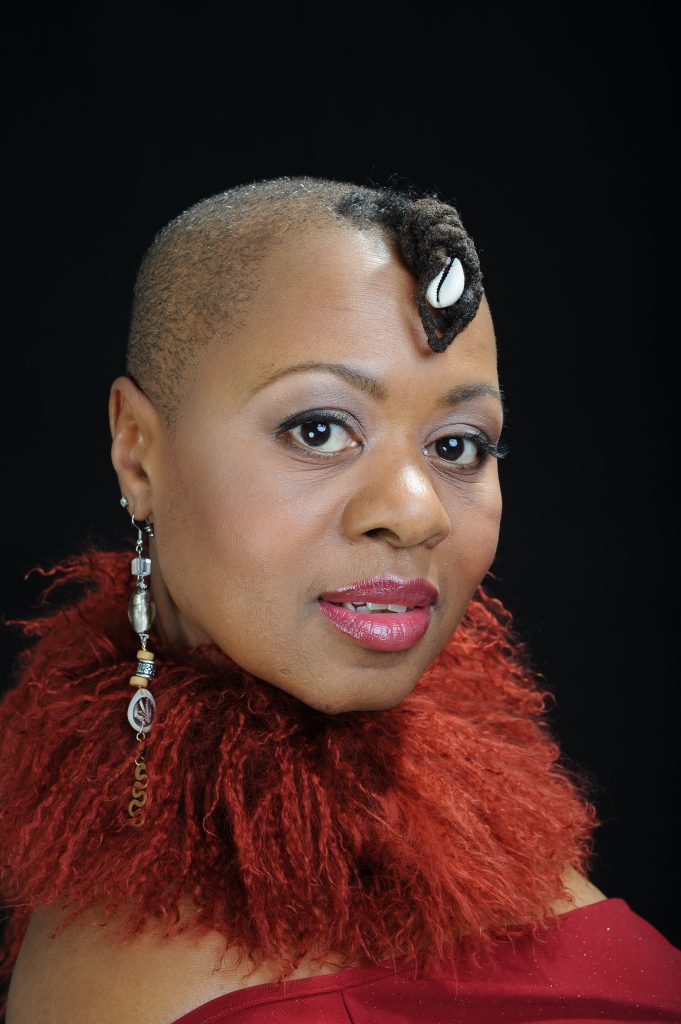
Dorree: How do you sustain yourself as an artist?
Aleathia: “I sustain myself by also having a Wellness practice. You are your own vessel for being able to create. So if I can’t see the canvas because my eyes have gone bad I have to take care of that from the inside out. Wellness is an integral part of aging. When I was in music and art high school my drawing teacher had severely arthritic fingers that were bent and deformed and I was diagnosed at 16 with arthritis in my hands and knees. I said, ‘oh no I’m not going to be like that.’ Look, [lifts hands to camera], my hands are not bent out of shape like that because of arthritis, I put practice into wellness. That way I can have the freedom to still be working. I’m pushing 60 but I’m not pushing 60.
Dorree: [Incredulously], “You’re pushing 60?”
Aleathia: I will be 59 in November so I’m pushing 60 right. I’m closer to it than away from it. I still climb up on my furniture when I gotta get to some box, I don’t even get a ladder. I am still dancing and rolling around on the floor to my house music. ‘What? I am not playing!’ [Laughter]. I wanna be 99 jumping rope being a beast’ because I want freedom. I like my freedom too much to be incarcerated by conditions and isms.”
Dorree: I’m just gonna carry that in my heart for as long as I can. Everything you said today is just so beautiful so lovely and it’s so clearly seen through your art. But to be able to speak with you and hear about your experience has truly been amazing.
You can learn more about Aleathia and see her work at: aleathiasart.us/
